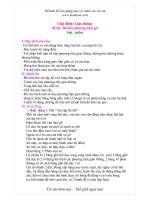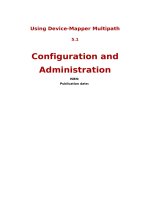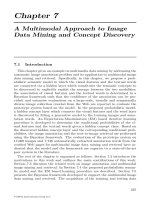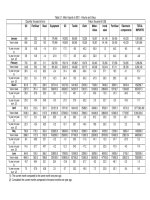Tài liệu Multimedia_Data_Mining_02 pptx
Bạn đang xem bản rút gọn của tài liệu. Xem và tải ngay bản đầy đủ của tài liệu tại đây (172.01 KB, 11 trang )
Part I
Introduction
27
© 2009 by Taylor & Francis Group, LLC
Chapter 1
Introduction
1.1 Defining the Area
Multimedia data mining, as the name suggests, presumably is a combi-
nation of the two emerging areas: multimedia and data mining. However,
multimedia data mining is not a research area that just simply combines the
research of multimedia and data mining together. Instead, the multimedia
data mining research focuses on the theme of merging multimedia and data
mining research together to exploit the synergy between the two areas to
promote the understanding and to advance the development of the knowl-
edge discovery in multimedia data. Consequently, multimedia data mining
exhibits itself as a unique and distinct research area that synergistically relies
on the state-of-the-art research in multimedia and data mining but at the
same time fundamentally differs from either multimedia or data mining or a
simple combination of the two areas.
Multimedia and data mining are two very interdisciplinary and multidis-
ciplinary areas. Both areas started in early 1990s with only a very short
history. Therefore, both areas are relatively young areas (in comparison, for
example, with many well established areas in computer science such as op-
erating systems, programming languages, and artificial intelligence). On the
other hand, with substantial application demands, both areas have undergone
independently and simultaneously rapid developments in recent years.
Multimedia is a very diverse, interdisciplinary, and multidisciplinary re-
search area
1
. The word multimedia refers to a combination of multiple media
types together. Due to the advanced development of the computer and dig-
ital technologies in early 1990s, multimedia began to emerge as a research
area [87, 197]. As a research area, multimedia refers to the study and de-
velopment of an effective and efficient multimedia system targeting a specific
application. In this regard, the research in multimedia covers a very wide
spectrum of subjects, ranging from multimedia indexing and retrieval, multi-
media databases, multimedia networks, multimedia presentation, multimedia
1
Here we are only concerned with a research area; multimedia may also be referred to
industries and even social or societal activities.
29
© 2009 by Taylor & Francis Group, LLC
30 Multimedia Data Mining
quality of services, multimedia usage and user study, to multimedia standards,
just to name a few.
While the area of multimedia is so diverse with many different subjects,
those that are related to multimedia data mining mainly include multime-
dia indexing and retrieval, multimedia databases, and multimedia presenta-
tion [72, 113, 198]. Today, it is well known that multimedia information is
ubiquitous and is often required, if not necessarily essential, in many appli-
cations. This phenomenon has made multimedia repositories widespread and
extremely large. There are tools for managing and searching within these
collections, but the need for tools to extract hidden useful knowledge embed-
ded within multimedia collections is becoming pressing and central for many
decision-making applications. For example, it is highly desirable for devel-
oping the tools needed today for discovering relationships between objects or
segments within images, classifying images based on their content, extract-
ing patterns in sound, categorizing speech and music, and recognizing and
tracking objects in video streams.
At the same time, researchers in multimedia information systems, in the
search for techniques for improving the indexing and retrieval of multimedia
information, are looking for new methods for discovering indexing informa-
tion. A variety of techniques, from machine learning, statistics, databases,
knowledge acquisition, data visualization, image analysis, high performance
computing, and knowledge-based systems, have been used mainly as research
handcraft activities. The development of multimedia databases and their
query interfaces recalls again the idea of incorporating multimedia data min-
ing methods for dynamic indexing.
On the other hand, data mining is also a very diverse, interdisciplinary,
and multidisciplinary research area. The terminology data mining refers to
knowledge discovery. Originally, this area began with knowledge discovery
in databases. However, data mining research today has been advanced far
beyond the area of databases [71, 97]. This is due to the following two rea-
sons. First, today’s knowledge discovery research requires more than ever the
advanced tools and theory beyond the traditional database area, noticeably
mathematics, statistics, machine learning, and pattern recognition. Second,
with the fast explosion of the data storage scale and the presence of multime-
dia data almost everywhere, it is not enough for today’s knowledge discovery
research to just focus on the structured data in the traditional databases;
instead, it is common to see that the traditional databases have evolved into
data warehouses, and the traditional structured data have evolved into more
non-structured data such as imagery data, time-series data, spatial data, video
data, audio data, and more general multimedia data. Adding into this com-
plexity is the fact that in many applications these non-structured data do not
even exist in a more traditional “database” anymore; they are just simply a
collection of the data, even though many times people still call them databases
(e.g., image database, video database).
Examples are the data collected in fields such as art, design, hyperme-
© 2009 by Taylor & Francis Group, LLC
Introduction 31
dia and digital media production, case-based reasoning and computational
modeling of creativity, including evolutionary computation, and medical mul-
timedia data. These exotic fields use a variety of data sources and structures,
interrelated by the nature of the phenomenon that these structures describe.
As a result there is an increasing interest in new techniques and tools that
can detect and discover patterns that lead to new knowledge in the problem
domain where the data have been collected. There is also an increasing in-
terest in the analysis of multimedia data generated by different distributed
applications, such as collaborative virtual environments, virtual communi-
ties, and multi-agent systems. The data collected from such environments
include a record of the actions in them, a variety of documents that are part
of the business process, asynchronous threaded discussions, transcripts from
synchronous communications, and other data records. These heterogeneous
multimedia data records require sophisticated preprocessing, synchronization,
and other transformation procedures before even moving to the analysis stage.
Consequently, with the independent and advanced developments of the two
areas of multimedia and data mining, with today’s explosion of the data scale
and the existence of the pluralism of the data media types, it is natural to
evolve into this new area called multimedia data mining. While it is pre-
sumably true that multimedia data mining is a combination of the research
between multimedia and data mining, the research in multimedia data mining
refers to the synergistic application of knowledge discovery theory and tech-
niques in a multimedia database or collection. As a result, “inherited” from
its two parent areas of multimedia and data mining, multimedia data mining
by nature is also an interdisciplinary and multidisciplinary area; in addition to
the two parent areas, multimedia data mining also relies on the research from
many other areas, noticeably from mathematics, statistics, machine learning,
computer vision, and pattern recognition. Figure 1.1 illustrates the relation-
ships among these interconnected areas.
While we have clearly given the working definition of multimedia data min-
ing as an emerging, active research area, due to historic reasons, it is helpful
to clarify several misconceptions and to point out several pitfalls at the be-
ginning.
• Multimedia Indexing and Retrieval vs. Multimedia Data Mining: It is
well-known that in the classic data mining research, the pure text re-
trieval or the classic information retrieval is not considered as part of
data mining, as there is no knowledge discovery involved. However, in
multimedia data mining, when it comes to the scenarios of multimedia
indexing and retrieval, this boundary becomes vague. The reason is that
a typical multimedia indexing and/or retrieval system reported in the
recent literature often contains a certain level of knowledge discovery
such as feature selection, dimensionality reduction, concept discovery,
as well as mapping discovery between different modalities (e.g., imagery
annotation where a mapping from an image to textual words is discov-
© 2009 by Taylor & Francis Group, LLC
32 Multimedia Data Mining
FIGURE 1.1: Relationships among the interconnected areas to multimedia
data mining.
ered and word-to-image retrieval where a mapping from a textual word
to images is discovered). In this case, multimedia information indexing
and/or retrieval is considered as part of multimedia data mining. On the
other hand, if a multimedia indexing or retrieval system uses a “pure”
indexing system such as the text-based indexing technology employed
in many commercial imagery/video/audio retrieval systems on the Web,
this system is not considered as a multimedia data mining system.
• Database vs. Data Collection: In a classic database system, there is
always a database management system to govern all the data in the
database. This is true for the classic, structured data in the traditional
databases. However, when the data become non-structured data, in
particular, multimedia data, often we do not have such a management
system to “govern” all the data in the collection. Typically, we simply
just have a whole collection of multimedia data, and we expect to de-
velop an indexing/retrieval system or other data mining system on top of
this data collection. For historic reasons, in many literature references,
we still use the terminology of “database” to refer to such a multime-
dia data collection, even though this is different from the traditional,
structured database in concept.
• Multimedia Data vs. Single Modality Data: Although “multimedia”
refers to the multiple modalities and/or multiple media types of data,
conventionally in the area of multimedia, multimedia indexing and re-
trieval also includes the indexing and retrieval of a single, non-text
© 2009 by Taylor & Francis Group, LLC









